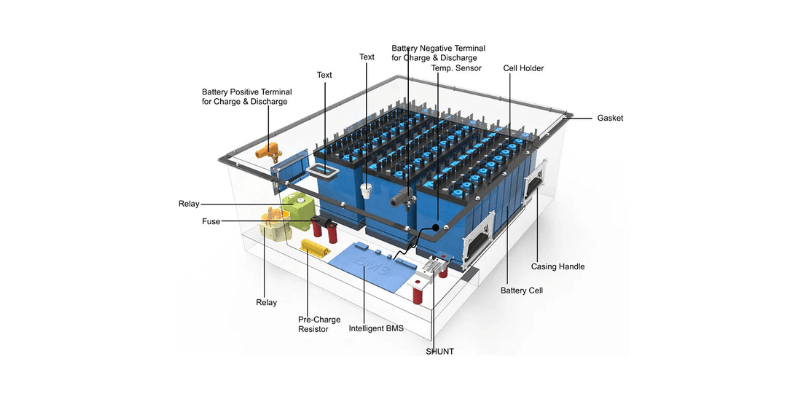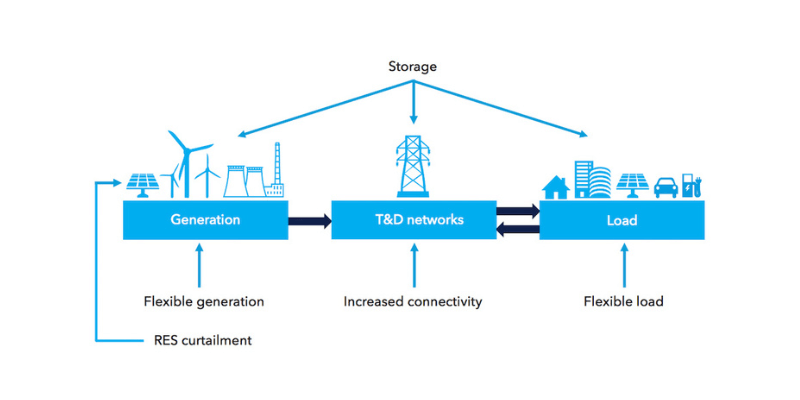Energilagring er afgørende for det moderne liv, da mange virksomheder er afhængige af batterier til elværktøj, belysning og udstyr på arbejdspladser. Når landstrøm ikke er tilgængelig, sikrer batterilagring ensartet drift i industrielle og kommercielle projekter. Lad os undersøge, hvordan dette fungerer.
Hvad er energi & Hvordan opbevares det?
Energi er evnen til at udføre arbejde og eksisterer i to hovedformer: kinetisk og potentiel energi.
For eksempel har en rullende sten kinetisk energi fra sin bevægelse, mens en sten ved kanten af en bakke har potentiel energi på grund af dens evne til at rulle.
Elektrisk energi betragtes som kinetisk, fordi den altid er i bevægelse, men kan omdannes til andre lagrede former for energi.
På samme måde repræsenterer vand bag en dæmning lagret potentiel gravitationsenergi.

Kan du opbevare elektrisk energi?
Nej, du kan ikke lagre elektricitet direkte, men den kan omdannes til lagerbare former. Denne energi kan senere omdannes tilbage til elektricitet. Elektriske energilagringsmetoder omfatter svinghjul (mekaniske), forhøjede vand eller vægte (tyngdekraft), trykluft (potentiale), kondensatorer (elektrisk ladning) og de mest almindelige: batterier (kemiske).
Hvad er et batteri?
Et batteri er en lagringsenhed, der omdanner kemisk energi til elektrisk energi. Den indeholder en eller flere elektrokemiske celler, hvor kemiske reaktioner skaber en strøm af elektroner, der giver den elektriske strøm, der er nødvendig for at udføre arbejde.
Batterier fungerer som elektronpumper med en positiv side (katode), en negativ side (anode) og en elektrolyt der reagerer kemisk med dem.
Selvom denne proces er fælles for alle batterier, lagrer forskellige typer energi på unikke måder.

Almindelige batterityper & Hvordan de opbevarer energi
Til industriel og kommerciel brug er der to hovedtyper af genopladeligt batterienergilagring, som adskiller sig i ydeevne.
Bly-syre batterier
Bly-syre-batterier, over 170 år gamle, er en af de ældste genopladelige batterityper.
Hvert 12-volts batteri består af seks celler med en blanding af svovlsyre og vand, med en positiv terminal (katode) og en negativ terminal (anode).
Ved udladning nedbrydes svovlsyre til vand og frigiver elektroner til elproduktion. Den kemiske reaktion ved den negative plade er: Pb(s) + HSO−4(aq) → PbSO4(s) + H+(aq) + 2e−
Under genopladning genopbygger energi syremolekylerne til fremtidig brug.
Selvom de er pålidelige og udbredte, har bly-syre-batterier begrænsninger; gentagne afladnings-genopladningscyklusser kan forkorte deres levetid på grund af aktiv materialenedbrydning.

Lithium-ion batterier
Tidligere talte vi om Katoder og anoder i batterier. De kan lagre lithiumioner, og energi lagres og frigives, når ionerne bevæger sig fra katode til anode gennem elektrolytten.
I modsætning til bly-syre-batterier, der bruger den samme kemiske reaktion, kommer lithium-ion-batterier i forskellige kemier. De top 6 typer omfatter Lithium Cobalt Oxide (LCO), Lithium Manganese Oxide (LMO), Lithium Nickel Manganese Cobalt Oxide (NMC), Lithium Nickel Cobalt Aluminum Oxide (NCA), Lithium Titanate (LTO) og Lithium Iron Phosphate (LFP).
Lithium-batterier er energitætte, mindre, lettere, oplades hurtigere og har en længere levetid sammenlignet med bly-syre-batterier.
Lithium jernfosfat batterier er specielt kendt for deres lange levetid og varmetolerance, hvilket gør dem sikrere og mere holdbare.

Fordelene ved batterienergilagring
Fordele ved et fleksibelt rent energinet
Udbredelsen af energilagring accelererer på grund af dens evne til at øge netfleksibiliteten, levere flere tjenester og anvendes på tværs af forskellige applikationer.
Lagersystemer kan integreres i elnettet – fra transmissionsnet til boligbyggerier.
Vedvarende energikilder som vind og sol har varierende output; således kan lagringsteknologier stabilisere elforsyningen ved at matche produktion med efterspørgsel.
Ved at oplade i tider med overskydende produktion og udledning under spidsbelastning, maksimerer energilagring den vedvarende brug og minimerer spild. Batterisystemer til boliger hjælper forsyningsselskaber med at matche kundernes efterspørgsel med variable strømforsyninger.
Opbevaring hjælper også med at reagere på pludselige ændringer i elbehovet, hvilket sikrer netstabilitet hurtigere end konventionelle kraftværker. Det er især vigtigt for landdistrikter eller isolerede mikronet, der er afhængige af lokale energiløsninger for at undgå strømafbrydelser.

Fællesskabsfordele
Energilagring kan forbedre adgangen og give fordele for lavindkomstsamfund, der er uforholdsmæssigt påvirket af forurening og klimaændringer. Det kan erstatte peak-anlæg med fossilt brændsel – ofte placeret i udsatte kvarterer, der forværrer luftkvalitetsproblemer i perioder med høj efterspørgsel som hedebølger.
Når batterilagring er billigere end gasturbiner, vil overgangen fra peaks accelerere.
Derudover hjælper energilagring kunder med at undgå toppriser ved at udjævne efterspørgselsstigninger svarende til stigninger i samkørselsomkostninger under ferier. Det forbedrer samfundets modstandskraft ved at imødekomme spidsbelastninger uden at belaste nettet eller forårsage prisstigninger under ekstremt vejr.
Ved at integrere vedvarende-genereret strøm i lokaliserede mikronet eller modstandsdygtige hubs, opnår lokalsamfund backup-energi under naturkatastrofer, mens de reducerer drivhusgasemissioner og er afhængige af forurenende fossile brændstoffer.

Konklusion
Mange mennesker bruger først batterier i RVing eller sejlsport, hvor pålidelig, sikker energilagring er afgørende for komforten. Batterier lagrer energi til omdannelse til elektricitet, hvilket forbedrer vores liv og giver frihed. Denne magt er synonym med selve friheden.

